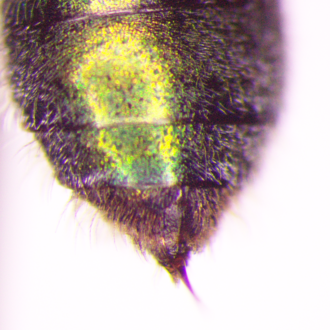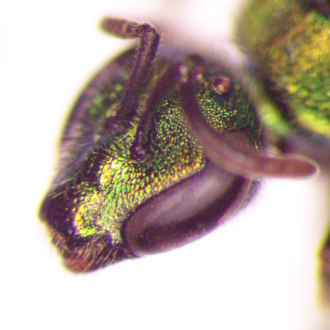Augochlorella aurata
| Augochlorella aurata | |
|---|---|

| |
| Scientific classification | |
| Domain: | Eukaryota |
| Kingdom: | Animalia |
| Phylum: | Arthropoda |
| Class: | Insecta |
| Order: | Hymenoptera |
| Family: | Halictidae |
| Tribe: | Augochlorini |
| Genus: | Augochlorella |
| Species: | A. aurata
|
| Binomial name | |
| Augochlorella aurata (Smith, 1853)
| |
| Synonyms | |
| |
Augochlorella aurata is a primitively eusocial species of sweat bee (bees attracted by the salt in human sweat) in the family Halictidae.[1][2][3] It is one of three species of Augochlorella found east of the Rocky Mountains in North America.[4] The body is a brilliant green metallic color, diffused to varying extents with a copper, red, or yellow color.[5] A. aurata is a generalist pollen feeder and likely an important pollinator for some horticultural crops.[4][6] A common name is golden green sweat bee.
Description and identification
Augochlorella aurata are usually a golden green color but can range from a metallic blue to a coppery pink. Both males and females of Augochlorella aurata are around 5-7mm with females usually slightly larger than males.[7] Like many bees, the females have 11 antennal segments and the males have 10.
Augochlorella aurata have a few specific characteristics that define them from other bees with similar appearance. Like many members of Halictidae, the tip of the mandible of these bees is rounded and said to be shaped like a glove or mitten. This character distinguishes them from Augochlora pura that bears similar resemblance but have forked mandible tips.[7][8][9] The propodeum is relatively uniform, with no ridge, separating it from bees in a closely related genus, Agapostemon.
The hind tibial spur is simple or slightly serrated, distinguishing it from the genus Augochloropsis. To distinguish Augochlorini bees from other Halictidae bees, Augochlorini females have abdominal T5 segment with a medial slit that originates on the rim and is at least a third of the longitudinal length of the segment.[8]
Additionally, the marginal cell of the forewing is pointed in Augochlorella aurata and squared off in Augochlora pura.[8][10]
-
Augochlorella aurata uncircled propodeum
-
T5 longitudinal medial slit on female Augochlorella aurata
-
Rounded mandible tip on Augochlorella aurata
Distribution and habitat

Augochlorella aurata is found throughout the United States, clustering mostly around the east coast and spreading westward.[7][11] Specifically, this species is found from Southern Canada south to Florida and west to Colorado and Texas.[4] There have been sparse occurrences of A. aurata as west as California and as south as South America. A. aurata inhabits the range furthest north in the Augochlorini tribe which is primarily distributed in the Neotropical region.[12]
Taxonomy and phylogeny
Augochlorella aurata is a bee within the family Halictidae, in which 4 subfamilies, 81 genera, and over 4,000 species are currently described.[13][14] It is within the monophyletic tribe Augochlorini[14] and within the monophyletic clade Augochlora which is composed of the four genera Augochlora (Smith), Augochlorella (Sandhouse), Ceratalictus (Moure), and Pereirapis (Moure) amounting to 150 species total.[12] Augochlorella contains 19 species and is sister to Augochlora.[12]
The tribe Augochlorini has eight described fossil species from Dominican amber and date back to the Early Miocene, estimated to be 20.44 to 30.82 million years ago.[12]
Colony cycle
Augochlorella aurata is a primitively eusocial ground nesting bee.[15][9] The colony season begins in spring with a foundress phase in which the overwintered female bee create a nest in the soil and will start a first brood of both males and females. The worker phase begins in early summer when the first brood emerges. The first-brood females become non-reproductively active workers, and the foundress stops all foraging to become the primary reproductive or the queen. In the reproductive phase, workers assist the queen in raising a second brood of both reproductive male and females towards the end of summer. The second brood will then mate in early fall, and the inseminated females overwinter to emerge the next spring as new foundresses.[15] The average number of offspring produced per nest is about 14 to 15 individuals.[16][15] Although most A. aurata will roughly stick to this colony cycle, some studies show occasional exceptions with some individuals going through the worker phase more than once or becoming completely solitary.[16]
Foraging and pollination
Augochlorella aurata is a polylectic forager meaning they visit many different plant species to collect pollen for feeding.[4] Generally, Augochlorella sp. have been observed visiting a variety of horticulturally significant crops including apple, blueberry, cantaloupe, coffee, cranberry, pepper, tomato, and watermelon.[6] Specifically, A. aurata have been formally observed visiting plants including tomato,[17] Echinacea,[18] and strawberry[19] though they likely visit many more plants due to their generalist pollen feeding habit.
References
- ^ "ITIS - Report: Augochlorella aurata". www.itis.gov. Retrieved 2021-10-11.
- ^ "Augochlorella aurata (Smith, 1853)". www.gbif.org. Retrieved 2021-10-11.
- ^ "Species Augochlorella aurata - Golden Green-Sweat bee". bugguide.net. Retrieved 2021-10-11.
- ^ a b c d Carril, Olivia; Wilson, Joseph (2021). Common Bees of Eastern North America (1st ed.). Princeton, New Jersey: Princeton University Press. ISBN 9780691175492.
- ^ "Augochlorella aurata". Discover Life. Archived from the original on 2017-03-18.
- ^ a b Kennedy, Christina M.; Lonsdorf, Eric; Neel, Maile C.; Williams, Neal M.; Ricketts, Taylor H.; Winfree, Rachael; Bommarco, Riccardo; Brittain, Claire; Burley, Alana L.; Cariveau, Daniel; Carvalheiro, Luísa G.; Chacoff, Natacha P.; Cunningham, Saul A.; Danforth, Bryan N.; Dudenhöffer, Jan‐Hendrik (2013). Anderson, Marti (ed.). "A global quantitative synthesis of local and landscape effects on wild bee pollinators in agroecosystems". Ecology Letters. 16 (5): 584–599. doi:10.1111/ele.12082. hdl:2263/31822. ISSN 1461-023X.
- ^ a b c "Discover Life, Augochlorella aurata". Archived from the original on 2017-03-18.
- ^ a b c "Discover Life Bee Genera".
- ^ a b "Golden Sweat Bee (Augochlorella aurata) | Vermont Atlas of Life". val.vtecostudies.org. Retrieved 2021-10-11.
- ^ "Key_To_Metallic_Green_Halictids". findtrees.blandy.virginia.edu. Retrieved 2021-10-28.
- ^ "Augochlorella aurata (Smith, 1853)". www.gbif.org. Retrieved 2021-10-11.
- ^ a b c d Gonçalves, Rodrigo Barbosa (January 2019). "Phylogeny of the Augochlora clade with the description of four new species (Hymenoptera, Apoidea)". Revista Brasileira de Entomologia. 63 (1): 91–100. doi:10.1016/j.rbe.2018.12.003.
- ^ "ITIS - Report: Halictidae". www.itis.gov. Retrieved 2021-10-28.
- ^ a b Gonçalves, Rodrigo Barbosa; De Meira, Odair Milioni; Rosa, Brunno Bueno (2022-07-29). "Total-evidence dating and morphological partitioning: a novel approach to understand the phylogeny and biogeography of augochlorine bees (Hymenoptera: Apoidea)". Zoological Journal of the Linnean Society. 195 (4): 1390–1406. doi:10.1093/zoolinnean/zlab098. ISSN 0024-4082.
- ^ a b c Mueller, Ulrich G. "Life History and Social Evolution of the Primitively Eusocial Bee Augochlorella striata (Hymenoptera: Halictidae)" (PDF). Journal of the Kansas Entomological Society: 116–138.
- ^ a b Packer, Laurence (July 2, 1990). "Solitary and eusocial nests in a population of Augochlorella striata (Provancher) (Hymenoptera; Halictidae) at the northern edge of its range" (PDF). Behavioral Ecology and Sociobiology. 27 (5): 339–344. doi:10.1007/BF00164004. S2CID 9648677.
- ^ Carrasco, Luis; Papeş, Monica; Lochner, Ellie N.; Ruiz, Brandyn C.; Williams, Abigail G.; Wiggins, Gregory J. (2021). "Potential regional declines in species richness of tomato pollinators in North America under climate change". Ecological Applications. 31 (3). doi:10.1002/eap.2259. ISSN 1051-0761.
- ^ Ison, Jennifer L.; Prescott, Leah J.; Nordstrom, Scott W.; Waananen, Amy; Wagenius, Stuart (2018). "Pollinator‐mediated mechanisms for increased reproductive success in early flowering plants". Oikos. 127 (11): 1657–1669. doi:10.1111/oik.04882. ISSN 0030-1299.
- ^ Connelly, Heather; Poveda, Katja; Loeb, Gregory (2015). "Landscape simplification decreases wild bee pollination services to strawberry". Agriculture, Ecosystems & Environment. 211: 51–56. doi:10.1016/j.agee.2015.05.004.
Further reading
- Ascher, J.S.; Pickering, J. (2019). "Discover Life bee species guide and world checklist (Hymenoptera: Apoidea: Anthophila)". Retrieved 2019-07-02.
External links
 Media related to Augochlorella aurata at Wikimedia Commons
Media related to Augochlorella aurata at Wikimedia Commons


